Creative Biolabs, a world leader in the industry of application-specific antibody development, has established an array of in vitro diagnostic (IVD) antibody development services that target numerous biomarkers to provide high-quality antibodies to our clients. Our scientists focused on IVD antibody development are pleased to assist you in your studies in a timely and cost-effective way.
About Salmonella
 Fig.1 The morphology of Salmonella.1
Fig.1 The morphology of Salmonella.1
Salmonella is an exceedingly common type of bacteria, which is a genus of gram-negative, rod-shaped (bacillus) bacteria belonging to the family Enterobacteriaceae. There are two species of Salmonella known as Salmonella bongori and Salmonella enterica, wherein Salmonella enterica is further divided into six subspecies including over 2,500 serotypes. These Salmonella bacteria are widespread and can be found in both warm-blooded and cold-blooded animals all over the world. Salmonella bacteria are non-sporing, motile enterobacteria with cell diameters between about 0.7 and 1.5 µm, lengths from 2 to 5 µm, and peritrichous flagella around the cell. Salmonella is so-called chemotrophs, which obtain the energy from oxidation and reduction reactions using organic sources. They are able to generate ATP with oxygen (called "aerobically") when available; while when the oxygen is not available, they can use other electron acceptors or fermentation (called "anaerobically"). Accordingly, they are also known as facultative anaerobes. Salmonella is one of the most common causes of diseases in humans.
Salmonella Bacterial Gastroenteritis
Salmonella is facultative intracellular pathogens since certain serotypes of Salmonella are able to cause disease. Most infections are caused by ingestion of food contaminated by human feces, or by animal feces. Salmonella serotypes can be mainly divided into two groups, typhoidal Salmonella and nontyphoidal Salmonella. Nontyphoidal serotypes are more common and can be transmitted from animal-to-human as well as from human-to-human. They usually invade the gastrointestinal tract and cause self-limiting gastrointestinal disease. Infection of nontyphoidal Salmonella commonly leads to food poisoning. Infection generally occurs when a human ingests contaminated foods which contain a high concentration of the bacteria. Only after the living salmonellae (not merely Salmonella-produced toxins) arrive at the gastrointestinal tract can an infection begin. Some of the bacteria are killed in the stomach, while the surviving ones reach the small intestine and proliferate in tissues. Although gastric acidity could destruct most of the ingested bacteria, Salmonella has evolved a degree of acid resistance that allows a subset of ingested bacteria to survive.
 Fig.2 Salmonella spp. infection pathogenesis. (Urdaneta and Casadesús, 2017)
Fig.2 Salmonella spp. infection pathogenesis. (Urdaneta and Casadesús, 2017)
Sources of Salmonella
- Raw meat, poultry and seafood (e.g. pork, beef, veal, chicken, turkey, and duck)
- Water
- Fertilizer
- Fruits and vegetables
Symptoms of Salmonella Infection
The incubation period of salmonellosis always ranges from several hours to two days. Its signs and symptoms are generally lasting two to seven days. The possible symptoms showed follow.
- Fever
- Nausea
- Chills
- Headaches
- Diarrhea
- Vomiting
- Abdominal cramps
- Hepatosplenomegaly
Diagnosis of Salmonellosis
The definitive diagnosis of Salmonellosis depends on the analysis of Salmonella isolated from bone marrow, blood or a specific anatomical lesion. The clinical symptoms characterizations and detection via antibody response enable the presentation of typhoid fever while blood culture is the mainstay for its diagnosis.
Salmonella Antibody Development Service
Antibodies are essential elements for immunodiagnostic tests to detect analytes in samples, such as blood, urine, and tissue. As an IVD antibody development partner, our team of technicians and specialists can help you develop novel antibodies for the detection of Salmonella. With our versatile IVD platform, Creative Biolabs is proud to develop novel Salmonella-specific antibody from scratch to commercial IVD kit (we can also start with provided antibody candidates).
If you are interested in our services, please feel free to contact us for more details.
References
- From Wikimedia: By US gov, Public Domain, https://commons.wikimedia.org/wiki/File:Salmobandeau.jpg.
- Urdaneta, Verónica, and Josep Casadesús. "Interactions between bacteria and bile salts in the gastrointestinal and hepatobiliary tracts." Frontiers in medicine 4 (2017): 163. Distributed under Open Access license CC BY 4.0, without modification.
For Research Use Only.

